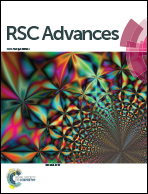Solvent optimization for bacterial extracellular matrices: a solution for the insoluble†
Abstract
Microbial biofilm systems are of industrial, environmental and medical concern. The existence of a structured matrix of extracellular polymeric substances (EPS) distinguishes biofilms from other bacterial communities. We contend that a lack of a cohesive framework for achieving solubilization of biofilm matrices contributes to suboptimal biofilm control strategies and a rudimentary understanding of important extracellular processes, such as cell–cell signaling and horizontal gene transfer. Here, we demonstrate that ionic liquids enable nonpolar systems for biofilm dissolution and allow the solubility parameter concept to be applied to a range of biofilms to identify optimum solvents. Solubilization was measured in terms of intrinsic solute viscosity (η), and Hildebrand solubility parameters (δ) for Pseudomonas aeruginosa rugose small colony variant biofilms and two distinct types of activated sludge biofilms were determined to be 24.8, 26.0 and 25.8 MPa1/2 respectively. Chromatographic separation of the matrix components of each biofilm was achieved in a 40 : 60 v/v blend of 1-ethyl-3-methylimidazolium acetate in N,N-dimethylacetamide, with partitioning of individual molecular weight fractions of each biofilm into the mobile phase accompanied by clear chromatographic peaks. While each biofilm may require its own specific solvent mixture, the work presented here provides a conceptual framework to enable the identification of that solvent mixture which will ultimately allow for the fractionation, isolation and characterization of hitherto intractable biofilm polymers.


 Please wait while we load your content...
Please wait while we load your content...